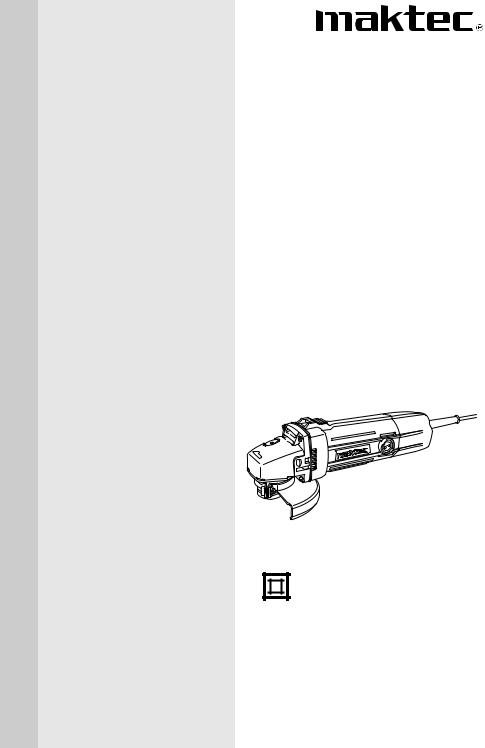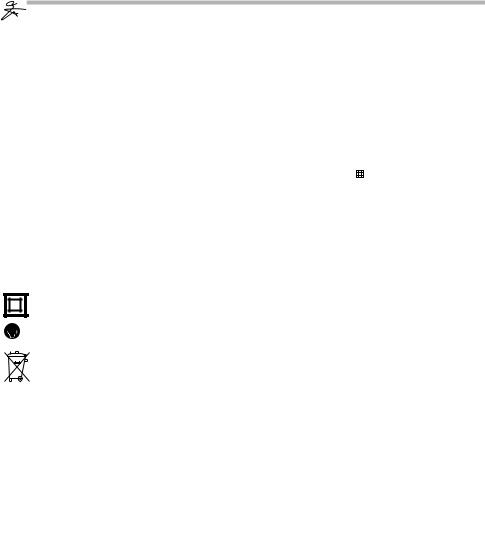Makita MT952, MT957 Manual

Angle Grinder
MODEL MT951
MODEL MT952
MODEL MT953
MODEL MT957
003565
DOUBLE
INSULATION
I N S T R U C T I O N M A N U A L
 WARNING:
WARNING:
For your personal safety, READ and UNDERSTAND before using. SAVE THESE INSTRUCTIONS FOR FUTURE REFERENCE.

SPECIFICATIONS
Model |
MT951 |
MT952 |
MT953 |
MT957 |
|
|
|
|
|
Wheel diameter |
100 mm |
115 mm |
125 mm |
125 mm |
|
|
|
|
|
Spindle thread |
M10 x 1.5 |
M14 x 2 |
M14 x 2 |
M14 x 2 |
|
|
|
|
|
No load speed (min-1) |
12,000 |
10,000 |
10,000 |
11,000 |
Overall length |
266 mm |
266 mm |
266 mm |
276 mm |
|
|
|
|
|
Net weight |
1.5 kg |
1.5 kg |
1.5 kg |
1.5 kg |
|
|
|
|
|
Safety class |
|
|
/II |
|
|
|
|
|
|
•Due to our continuing programme of research and development, the specifications herein are subject to change without notice.
•Note: Specifications may differ from country to country.
Symbols |
END202-2 |
The following show the symbols used for the tool. Be sure that you understand their meaning before use.
 ...................Read instruction manual.
...................Read instruction manual.
...................DOUBLE INSULATION
 .....................Wear safety glasses.
.....................Wear safety glasses.
..................Only for EU countries
Do not dispose of electric equipment together with household waste material!
In observance of European Directive 2002/96/EC on waste electric and electronic equipment and its implementation in accordance with national law, electric equipment that have reached the end of their life must be collected separately and returned to an environmentally compatible recycling facility.
Intended use
The tool is intended for grinding, sanding and cutting of metal and stone materials without the use of water.
Power supply
The tool should be connected only to a power supply of the same voltage as indicated on the nameplate, and can only be operated on single-phase AC supply. They are double-insulated in accordance with European Standard and can, therefore, also be used from sockets without earth wire.
For Model MT951
For European countries only Noise and Vibration
The typical A-weighted sound pressure level is 85 dB (A). The noise level under working may exceed 85 dB (A).
– Wear ear protection. –
The typical weighted root mean square acceleration value is 4 m/s2.
For Model MT952/MT953 For European countries only Noise and Vibration
The typical A-weighted sound pressure level is 83 dB (A). The noise level under working may exceed 85 dB (A).
– Wear ear protection. –
The typical weighted root mean square acceleration value is 3 m/s2.
EC-DECLARATION OF CONFORMITY
We declare under our sole responsibility that this product is in compliance with the following standards of standardized documents, HD400, EN50144, EN55014, EN61000 in accordance with Council Directives, 73/23/ EEC, 89/336/EEC, 98/37/EC.
Yasuhiko Kanzaki CE 2004
Director
MAKITA INTERNATIONAL EUROPE LTD.
Michigan Drive, Tongwell, Milton Keynes, Bucks MK15 8JD, ENGLAND
Responsible manufacturer:
Makita Corporation Anjo Aichi Japan
2

SAFETY INSTRUCTIONS |
ENA001-2 |
 WARNING:
WARNING:
When using electric tools, basic safety precautions, including the following, should always be followed to reduce the risk of fire, electric shock and personal injury. Read all these instructions before operating this product and save these instructions.
For safe operations:
1.Keep work area clean.
Cluttered areas and benches invite injuries.
2.Consider work area environment.
Do not expose power tools to rain. Do not use power tools in damp or wet locations. Keep work area well lit. Do not use power tools where there is risk to cause fire or explosion.
3.Guard against electric shock.
Avoid body contact with earthed or grounded surfaces (e.g. pipes, radiators, ranges, refrigerators).
4.Keep children away.
Do not let visitors touch the tool or extension cord. All visitors should be kept away from work area.
5.Store idle tools.
When not in use, tools should be stored in a dry, high or locked up place, out of reach of children.
6.Do not force the tool.
It will do the job better and safer at the rate for which it was intended.
7.Use the right tool.
Do not force small tools or attachments to do the job of a heavy duty tool. Do not use tools for purposes not intended; for example, do not use circular saws to cut tree limbs or logs.
8.Dress properly.
Do not wear loose clothing or jewellery, they can be caught in moving parts. Rubber gloves and non-skid footwear are recommended when working outdoors. Wear protecting hair covering to contain long hair.
9.Use safety glasses and hearing protection.
Also use face or dust mask if the cutting operation is dusty.
10.Connect dust extraction equipment.
If devices are provided for the connection of dust extraction and collection facilities ensure these are connected and properly used.
11.Do not abuse the cord.
Never carry the tool by the cord or yank it to disconnect it from the socket. Keep the cord away from heat, oil and sharp edges.
12.Secure work.
Use clamps or a vice to hold the work. It is safer than using your hand and it frees both hands to operate the tool.
13.Do not overreach.
Keep proper footing and balance at all times.
14.Maintain tools with care.
Keep cutting tools sharp and clean for better and safer performance. Follow instructions for lubrication and changing accessories. Inspect tool cord periodically and if damaged have it repaired by an authorized service facility. Inspect extension cords periodically and replace, if damaged. Keep handles dry, clean and free from oil and grease.
15.Disconnect tools.
When not in use, before servicing and when changing accessories such as blades, bits and cutters.
16.Remove adjusting keys and wrenches.
Form the habit of checking to see that keys and adjusting wrenches are removed from the tool before turning it on.
17.Avoid unintentional starting.
Do not carry a plugged-in tool with a finger on the switch. Ensure switch is off when plugging in.
18.Use outdoor extension leads.
When tool is used outdoors, use only extension cords intended for outdoor use.
19.Stay alert.
Watch what you are doing. Use common sense. Do not operate tool when you are tired.
20.Check damaged parts.
Before further use of the tool, a guard or other part that is damaged should be carefully checked to determine that it will operate properly and perform its intended function. Check for alignment of moving parts, free running of moving parts, breakage of parts, mounting and any other conditions that may affect its operation. A guard or other part that is damaged should be properly repaired or replaced by an authorized service center unless otherwise indicated in this instruction manual. Have defective switches replaced by an authorized service facility. Do not use the tool if the switch does not turn it on and off.
21.Warning.
The use of any accessory or attachment, other than those recommended in this instruction manual or the catalog, may present a risk of personal injury.
22.Have your tool repaired by a qualified person.
This electric tool is in accordance with the relevant safety requirements. Repairs should only be carried out by qualified persons using original spare parts, otherwise this may result in considerable danger to the user.
3
